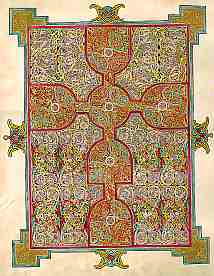
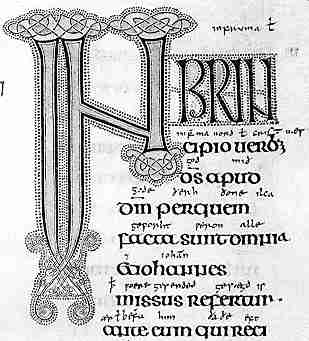

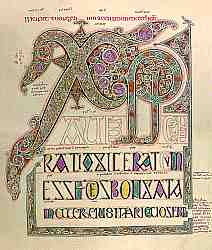
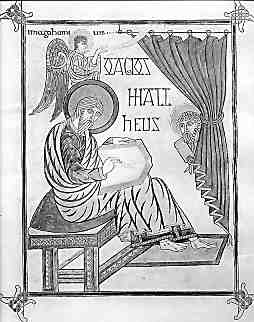
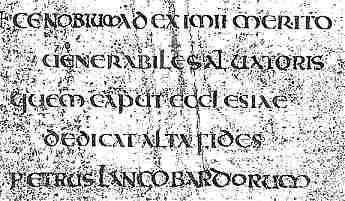
If you are looking at this page without frames, there is more information about medieval writing to be found by going to the home page (framed) or the site map (no frames).
| Early Bibles and Gospels (3) | |||||

|
The Lindisfarne Gospels represents the national masterpiece of England, or arguably, the national masterpiece of Northumberland, as there are moves to have it removed from the monolith of the British Library and restored to a rightful home in the north. Dating from the late 7th century, it has comparable features with the Book of Kells, not least elaborate decorative schemes, insular half uncial script and a legend of loss and recovery. It has an exquisitely wrought jewelled cover, but that was made in the mid 19th century utilising design schemes derived from inside the book. The book as object has a long history. | ||||
| A page consisting entirely of an elaborate crucifix with complex interlace designs, f.26b, one of five such pages in the Lindisfarne Gospels, sometimes referred to as carpet pages (British Library, Cotton Nero D IV). (Click on image for a larger version.) | |||||
| Information about the Lindisfarne Gospels has been obtained from J. Backhouse 1981 The Lindisfarne Gospels Oxford: Phaidon and from E.G. Millar 1923 The Lindisfarne Gospels London: British Museum, from which the illustrations on this page were also derived. The colour illustrations seem a trifle muddy compared to the original. A selection of high quality illustrations from the Backhouse book and a summarised text by the author can be found on the web site The Lindisfarne Gospels. The British Library itself has a few images scattered about. Just type "Lindisfarne Gospels" into the search box and hope for the best. Their new version of the Turning the Pages Technology, which is supposed to give you a look at numerous pages, is as hopelessly overtechnologised and underproductive as ever. I don't know why they don't just put up a plain and sensible image gallery. | |||||
| The text of this work is the standard Vulgate, preceded by the text of St Jerome's letter to Pope Damasus, at whose command the revision had been carried out. There is a prologue to St Jerome's commentary on Matthew and a set of Eusebian canon tables. Each gospel is preceded by an argumentum, or introduction, a capitula lectionum, or list of passages used as liturgical readings, and a list of festivals at which the passages should be read. The list of festivals suggests a connection with Naples, indicating that the exemplar from which the book was copied was a gospel book imported from southern Italy. | |||||
 |
The script of the main text is an insular half uncial, or insular majuscule. There are many decorative initials and a very distinctive form of heading script. The tiny writing between the lines is a gloss added in the 10th century, translating it into Old English. This is in a pointed insular minuscule. | ||||
| Section from the capitula to St John, detail of f.204. | |||||
| A script sample and paleography exercise for a segment from this book can be found on this website here. | |||||
| There is a colophon in Old English at the end of the book, added not by the original scribe, but by the scribe who produced the gloss. Aldred, most unworthy and miserable priest. This records something of the history of the book, or rather the legend, unless you actually believe that Eadfrith, bishop of Lindisfarne, wrote it with his own hand and Ethelwald, bishop of the Lindisfarne islanders, personally manufactured the cover. This, I think, is in the same category of high class association as King Alfred translating the Bible or Charlemagne reforming the liturgy. The top men always get the credit. | |||||
 |
|||||
| The first few lines of the colophon. No, he didn't write straight. | |||||
| There is a script sample and paleography exercise for the colophon on this website here. | |||||
 |
As with the Book of Kells, certain significant passages were singled out for exceptional decorative treatment. This is the Lindisfarne version of the Chi-Rho page, with the XPI monogram entirely filled with complex interlace swirls. The first few lines of text are in an unusual angular heading script that was evidently particular to the Lindisfarne scriptorium. There is also a line of insular half uncial at the top, and bits of the Old English gloss are dotted about the page. The second line does not appear to be completed as the letters are not filled in. Oversight, interruption, or a desire not to upset a jealous God by making it too perfect? | ||||
| Matthew i. 18, f.29. (Click on image for a larger version) | |||||
 |
The Lindisfarne Gospels also has its figural depictions derived from Classical models. While not so awkwardly rendered as some of those in the Book of Kells, they have some iconographic mysteries. In this depiction of St Matthew, the figure peeking from behind the curtain has been variously identified as the Holy Ghost, the Almighty, Gregory, Jerome, the second person of the Trinity, or possibly a duplication of the Matthew figure. | ||||
| Image of the evangelist Matthew, f.25b. | |||||
| While these volumes were probably not penned by the bishops themselves, the scribes who produced them were monks in the monasteries where they were used. Books were borrowed from other monasteries for copying and returned. Exemplars were sent out from Rome to allow the monks to make multiple copies. Monks travelled to monastic enclaves outside their native lands and copied books in the scripts they had learned at home, so that a prestige work like the Echternach Gospel, named after the German monastery where it resided but now in the Bibliothèque Nationale in Paris, was written in insular script. | |||||
| A Bible manuscript known as the Codex Amiatinus has been identified as one of three written by order of Ceolfrid, abbot of Jarrow, and taken by him in 716 for presentation to the pope. Unfortunately, the abbot died on the journey. It is identified through similarities in its miniatures and specifics of text to the Lindisfarne Gospels, and from some details erased and overwritten on the dedication page. However, it is an early precursor of a later type of work, a complete text of all the Bible, Old and New Testaments. | |||||
 |
Detail of the dedication page of the Codex Amiatinus (Florence, Biblioteca Laurentiana). The words Petrus Langobardorum have replaced the original words Ceolfridus Anglorum which have been erased. (From Steffens 1929) | ||||
| The script of this work is not the insular half uncial used in the Lindisfarne Gospels, but a rather formal and laboured uncial, described by some authors as decadent. It has been suggested that the work was actually copied by Italian scribes working in the monastery of Jarrow, but perhaps a scribe of Jarrow was toiling away outside his own cultural tradition to produce a work perceived to be more suited to its prestigious recipient. The lines are laid out according to a system called per cola et commata, which means essentially that the line and word spacing are set out carefully for reading aloud, rather than in the endless stream of early uncial texts. These prestige works are not just artistic masterpieces, but material objects from which can be deduced, however imperfectly, the relationships of intellectual culture during what we choose, in our ignorance, to call the Dark Ages. | |||||
| Not all Biblical works were for presentation to the pope. | |||||
|
|
|||||
|
|
|||||
|
|
|||||
|
If you are looking at this page without frames, there is more information about medieval writing to be found by going to the home page (framed) or the site map (no frames). |
|||||